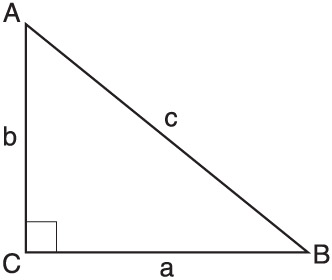Problem: We have found 6 of the trigonometric derivatives. And now, we need the last 3.
After doing 6 of these, we'd expect them to get easier, because of practice. That is just not the case. Because these are inputting the ratios and extracting the angles, these aren't as easy as the others. We're going to have to look at a triangle and try to understand exactly what we're doing.
After doing 6 of these, we'd expect them to get easier, because of practice. That is just not the case. Because these are inputting the ratios and extracting the angles, these aren't as easy as the others. We're going to have to look at a triangle and try to understand exactly what we're doing.
So we're going to look at angle B. The following statement is true:
sin(B)=b/c
However, we want this thing in terms of x. So I'm going to set b/c=x, and B=y, just for the sake of using x and y.
Because sin(y)=x, arcsin(x) must be y as well.
So we will find the derivative of sin(y)=x with respect to x.
By taking the derivative, sin(y) becomes cos(y), but there is a chain rule within this, so we multiply by the derivative of the inside (which is y'). And the derivative of x is 1. The derivative is now y', so we should solve for that.
Now the issue becomes: We need this in terms of x, since that's what the derivative is all about. However, we can't just plug in arcsin(x) for y, or it just looks bad. So I'm gonna rewrite cos(y) in terms of sine. We can do this using the following trigonometric identity:
sin2(x)+cos2(x)=1
We can get the following statement:
Then we can substitute arcsin(x) for y, and simplify to find that the derivative of arcsin(x) is:
Next, we can apply a similar tactic to arccosine. In fact, I'm realizing it's the exact same situation, except because the derivative of cos(x) is -sin(x), the derivative is just going to be mirrored across the x-axis, which is proven here.
I used a program called "MathType" to speed up the process. That's why the fractions look the way they do. I would have changed it, but I don't exactly know how, and I'm not quite willing to find out right now.
Now, I have to find the derivative of arctan(x), which is the last one. Luckily, it follows the same rules.
This is what I have so far, but now I have to write this in terms of tan(y). Looking at it, it actually seems intimidating at first, but it's actually quite simple. Because cos(x)=1/sec(x), we can use a trigonometric identity here.
Now, we just have to get this in terms of x, which shouldn't be difficult, considering tan(arctan(x))=x.
And there we go! Now we have the trigonometric derivatives of sine, cosine, tangent, cosecant, secant, cotangent, arcsine, arccosine, and arctangent.





































